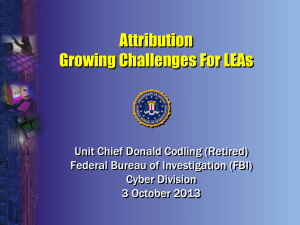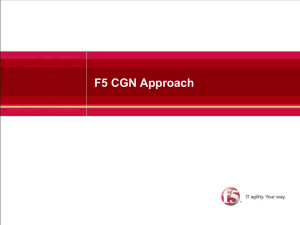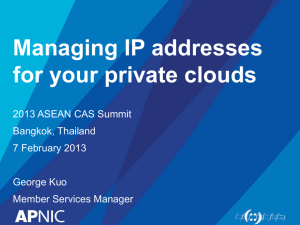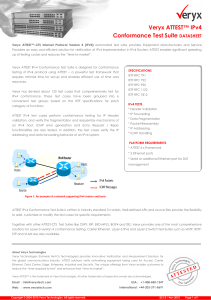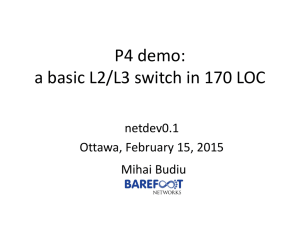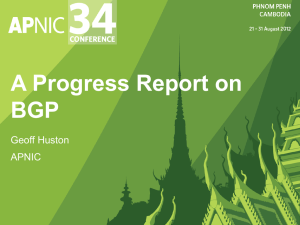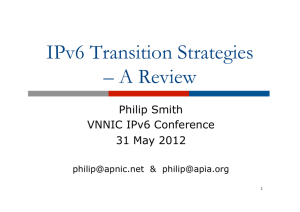Document
advertisement
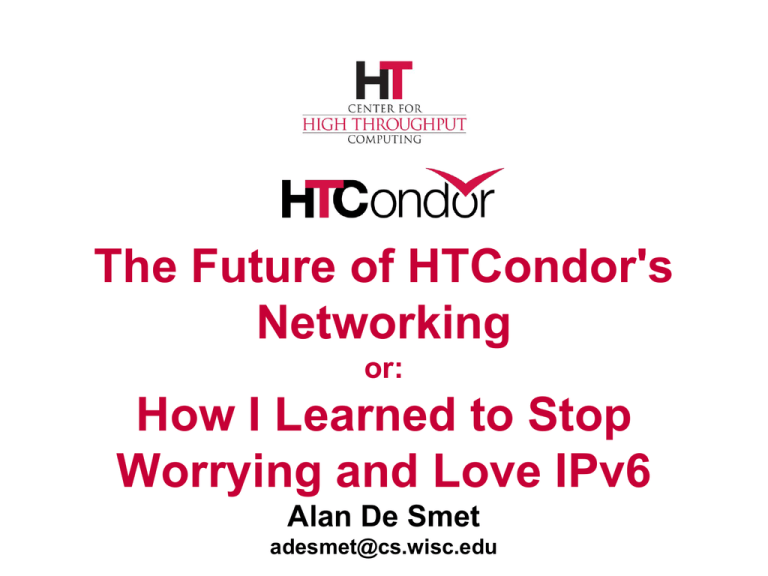
The Future of HTCondor's Networking or: How I Learned to Stop Worrying and Love IPv6 Alan De Smet adesmet@cs.wisc.edu 8.0: The Past 2 CCB: Condor Connection Broker schedd Internet 3 Outbound firewall CCB startd schedd Internet 4 Fire wall condor_shared_port shared_port startd starter Beating the 65,535 limit CCB shadow ⋮ shadow shared_port shadow starter starter Internet ⋮ starter 5 Do-It-Yourself Name Service › Minimal DNS dependency Working to reduce! › Centralized service: condor_collector › More than addresses; routes! CCB, shared_port 6 IPv6 support › IPv4 by default › ENABLE_IPV6=TRUE Disables IPv4 Lots of odd limitations › Only one interface (sorta) 7 8.1 & 8.2: The Present › IPv4 by default › ENABLE_IPV6=TRUE IPv4 stays on! Lots of odd limitations › Using IPv6 today? Also do ENABLE_IPV4=FALSE 8 8.1 & 8.2: The Present › › › › Mixed mode IPv4 and IPv6! Sorta Kinda Not really 9 8.1 & 8.2: The Present › Mixed mode IPv4 and IPv6? › Simple queries › You might get matchmaking working No support › Multiple interfaces are supported, but… › …only the IPv4 address is advertised 10 8.3 & 8.4: The Future › Mixed mode IPv4 and IPv6! Really! › Mixed pools! (Mixed matchmaking?) › Multiple interfaces that work! IPv4-only hosts Mixed mode hosts CCB? Mixed mode central manager 11 IPv6-only hosts › › › › 8.3 & 8.4: The Future Mixed mode IPv4 and IPv6! Really! Mixed pools! (Mixed matchmaking?) Multiple interfaces that work! Complete overhaul of address representation! 12 A complete what now? › Complete overhaul of address representation! 13 Addresses Today › Today: Sinful Strings. Simple, elegant <173.194.46.96:80> <192.168.1.55:9618?PrivNet=example.com &PrivAddr=192.168.1.55&sock=1567_808b_ 3&CCBID=173.194.46.96:80#381> 14 Addresses Today › New features bolted on Backward compatible Minimal changes / Maximal stability Fast development <192.168.1.55:9618?PrivNet=example.com &PrivAddr=192.168.1.55&sock=1567_808b_ 3&CCBID=173.194.46.96:80#381> › IPv6 would double the complexity › What about IPv8, or CCB2, or Unix Domain Sockets, or… 15 Future Addresses › Making a new way to describe addresses › Extensible, support complex data structures › Generalize specific techniques from Sinful strings › Backward compatible for one major version: support both old and new versions 16 Generalizing Lessons 17 Multi-Stage Routing <192.168.1.55:9618? CCBID=173.194.46.96:80#381%3F sock%3D917_aa8b_3& sock=1567_808b_3> CCB shared_port schedd shared_port startd 18 Multi-Stage Routing › Proxies CCB, shared_port (sorta) CCB2?, SOCKS?, HTTP CONNECT? › Special setup VPNs? SDN dynamic routes? Port knocking? › Multiple routes simultaneously? budget channel bonding 19 Multi-Stage Routing (IPv4, 42.82.111.3, 9618), (SharedPort, 381_382b_3), (CCB, 37349), (SharedPort, 5491_b8c1_1) 1. IPv4: Connect to 42.82.111.3 port 9618 2. shared_port: ask for 381_382b_3 3. CCB: ask for 37349, wait for reverse connection 4. shared_port: ask for 5491_b8c1_1 5. startd! › Might be a DAG… 20 Multiple Routes <192.168.1.55:9618? PrivNet=example.com& PrivAddr=192.168.1.55& CCBID=173.194.46.96:80#381> › We may not be able to use them all 21 Multiple Routes › Different protocols: IPv4, IPv6 IPv8?, Unix Domain Sockets? › Accessibility: public, private multiple private networks? fast versus cheap? 22 Multiple Routes › A list of routes, identified by starting network example.com, (IPv4, 192.168.1.55, 9618), (SharedPort, 5491_b8c1_1) public, (IPv4, 173.194.46.96, 80), (CCB, 381), (SharedPort, 5491_b8c1_1) 23 Bi-directional Routing › Matchmaking Can the schedd reach the startd? What if the startd needs to reverse the connection? › Today: no support › Advertise which networks and protocols the daemon can connect to Private:UW, IPv4 Internet, IPv6 Internet, IPv4 24 Client Route Selection › A client has a choice of routes, which one? › RFC 6724: Default Address Selection for Internet Protocol Version 6 (IPv6)? We're not using DNS We're way weirder than DNS 25 Client Route Selection › Client obtains (from the collector) the list of the endpoint’s inbound paths. › Client discards inbound paths which it can not reach. Client can reach a path if one of its outbound paths terminates with a protocol and a network name identical to the protocol and network name of the inbound path in question. › Client discards any remaining reversing paths that can not reach it. A reversing path can reach the client if the reachable set of each reversing step includes a protocol and network name pair identical to one terminating one of the client’s return paths. › Clientconstructs the complete path corresponding to each remaining inbound path. › The client tries one or more of the complete paths, in whatever order or concurrency it finds appropriate. For each path it tries, the client interacts with each step appropriately. For a reversing step, this will include supplying a list of reachable return paths, which the client may need to configure. 26 Toward a bold new future of glasnost between IPv4 and IPv6! 27

